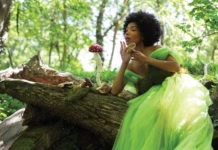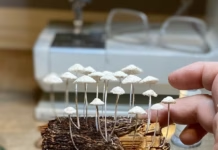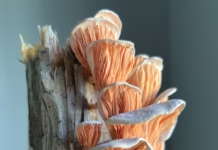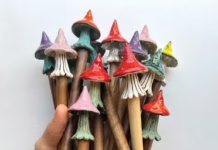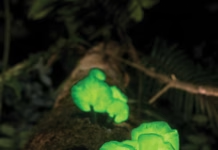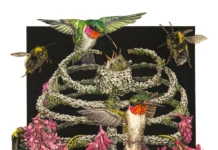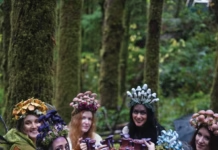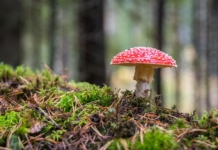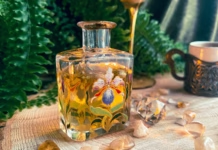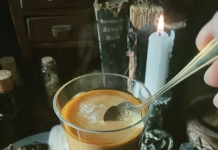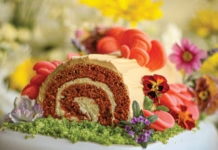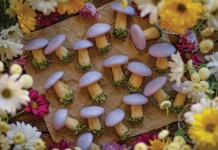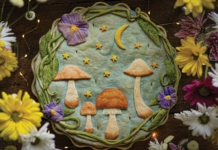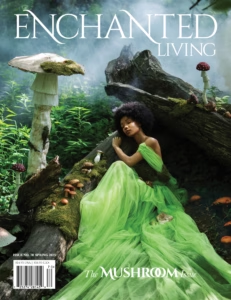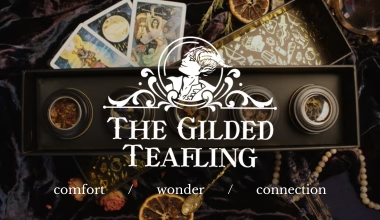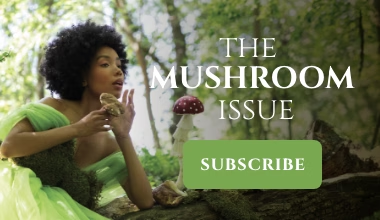Feature Image: Hollow Bones by Katrina Haffner
As I’m down on all fours, balanced on one hand and one knee with my opposite leg suspended in the air behind, I hear the instructor intone, “How we begin is not how we end.” He means that our physical state is always changing, that we walk out of the barre studio a little stronger, a little more flexible than we were when we came in.
The year is preparing to turn as I write this, and as it does, millions of people will resolve to begin the New Year by acting, speaking, eating, working, relating to others, and simply being in a way that is different from and hopefully better than whatever they did before. A lot of coaches like to focus on how quickly many resolutions are forgotten or broken, but I think it’s remarkable that we always resolve to change, and how deep down we know that how we begin is not—and doesn’t have to be—how we end.
I like to take my prayers outside. Next to the swing and the backyard fountain is a patch of dirt that wasn’t always there. When we first moved into the house there was a tough, gnarled tree stump in its place. I don’t know what happened to the tree, but I do know that our local mushroom population loved that stump. I watched as a variety of fungi worked on the wood, slowly breaking it down until it disappeared completely. Although it didn’t, not really. It just changed.
I’ve always loved mushrooms. Forever associating them with magic and the line that they straddle—nourishment and healing on one side, death on the other—I find their folklore and their varieties endlessly fascinating. In school we learned to call them decomposers, a special class of plant and fungi that feeds on organisms already dead, thus transforming death into something that can support life once more.
Death is not an end but a new beginning may sound like a cliché, but the fact is that everything in and around us is constantly dying, transforming, and becoming something else. Fungi are the allies that remind us that such a cliché also happens to be absolute truth.
Interestingly, advanced medical research into fungi reveals similar functions on a less physical or literal plane. Many people ingest reishi and lion’s mane to bring life back to overtaxed immune systems. Some scientists are experimenting with various species of psilocybin, exploring their use not just for a good time but also to help people trapped in psychological death states, which might include emotional paralysis, deep depression, and trauma that leave them feeling frozen and isolated.
In his wonderful book on all things fungal, Entangled Life: How Fungi Make Our Worlds, Change Our Minds, and Shape Our Futures, Merlin Sheldrake points out that the treatment of bacterial infections with antibiotics is being challenged in a deep way by fungal infections, which are poised to become more frequent and deadly. This danger has spurred medical researchers to find new and better treatment protocols and has served as a reminder to all of us that an overreliance on antibiotics leaves everyone vulnerable.
I spread truffle-infused honey on a slice of hot buttered bread for my oldest son. He’s been through so much: loss of vision in one eye, the possibility of losing vision in the other eye, the relief when the medical procedure worked and preserved that second eye’s sight. Through it all—the trauma, the surgeries, the fear—he has been so brave … and he’s grown so tall that he now towers above me. He’s grown too in talent, in his ability as a cellist, pianist, and composer, and most of all in wisdom. I think about the changes he’s been through, and then my gaze falls on an orange and blue ceramic piece made by my youngest son. It’s a mushroom. I keep it on my desk to remind me that how we begin is not how we end. Living life leaves a mark.
I am back in class, this time doing forward and reverse lunges at the barre. I breathe into the motion. I reflect on how the greatest quality of fungus is not that it decomposes or that it can open doors of perception, but that it connects. Tiny white hyphae reach for each other, fungal filaments that we now know are required for life, because connection is required for life.
Connection of tree to tree and tree to forest and forest to forest; connection of soil to soil, of each web of life to all others.
My hair is damp with sweat; my thoughts turn to spring and that patch of dirt in my backyard where there used to be a stump of wood. What shall I plant there this season? What new life has death made way for? What is ready to grow? I’m not sure yet, but I’m ready to find out.




